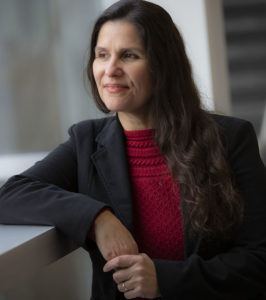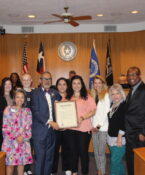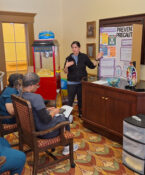Start planning for a safe holiday season now
Fall and winter holidays will have a different feel during COVID-19 as families consider the safest ways to celebrate their usual traditions with friends, neighbors and loved ones.
It’s still possible to enjoy the season during the pandemic, said HSC’s Dr. Diana Cervantes, by approaching your plans and festivities in creative, new ways.
“Even though our world is different right now, people still want to maintain their traditions with those who are closest to them,” she said. “By practicing safe COVID guidelines and rethinking the possibilities, there’s no reason to have to miss the big events you enjoy celebrating each year.”
An Assistant Professor and Director of the HSC School of Public Health MPH Epidemiology Program, Dr. Cervantes is considered one of Tarrant County’s most trusted experts on COVID-19 safety, offering the community a steady stream of information and advice these last several months based on public health guidance and science.
“Halloween is all about masks anyway, so why not create your own this year,” she suggests.
“Kids can have fun designing cloth or surgical masks in clever ways. It only requires a few craft supplies you can order online.”
Going big with your decorations both inside and outside is also a good way to get in the “spirit,” she said, and the more elaborate your lights, sounds, effects and front-yard scenes, the better.
Socially distanced costume parades on bicycles can be a great way to shift the focus away from group gatherings on neighbors’ doorsteps. Individual, small bags or cups of candy set outside on a festive table, or in strategic places around the front lawn, are good ways of distributing treats during the pandemic.
“It’s just not the time for all those little hands to reach into the same candy bowl,” Dr. Cervantes said.
Zoom costume parties and virtual pumpkin-carving contests are other ideas she suggests this year.
Thanksgiving is another big holiday just around the corner, and many families are approaching this one in unique ways as well.
“The safest way to get together in person is outside, in small groups of no more than 10,” Dr. Cervantes said. “Even with the Zoom exhaustion many people seem to be feeling right now, virtual events are also good choices.”
“Maintaining holiday traditions as safely as possible has a positive impact on mental health and can provide some much-needed relief to the pandemic isolation of the last several months.”
Bringing everyone into the planning makes it more of a “together” event. Dr. Cervantes recommends having honest conversations about your personal comfort levels and “non-negotiables.”
“If something doesn’t feel safe to you, don’t be afraid to voice your concerns,” she said. “We all want to be sensitive to the health of others, especially older adults, those with underlying health conditions and people at higher risk. It’s always your choice to skip an event, or to set the guidelines if you’re the host.”
Outdoor parties should have backup weather plans, including alternate rain dates and ways to keep warm if temperatures get chilly.
Social distancing, with tables set six feet apart for guests from different households, is still the recommendation, and masks should be available and easily accessible if someone has to go inside or be within close distance of other guests, especially those at high risk like the elderly.
“I like to provide ‘pandemic preparedness party packs’ for each table, with hand sanitizers, disposable napkins, masks in case they forget theirs and other items they might need,” Dr. Cervantes suggests.
Plans can include disposable plates and cutlery, with plenty of outdoor trashcans in strategic places. To further minimize risk, guests should avoid sharing drinks and food. Brainstorm ways to keep smaller kids occupied and in their own space.
“Kids like to hug, and especially if they haven’t seen grandparents or other relatives in a while, it can be a challenge,” Dr. Cervantes said. “Consider table games, puzzles, crafts, contests, bingo, an outdoor movie or other interesting options.”
Bathrooms pose challenges during COVID. One way to prepare, Dr. Cervantes recommended, is with paper towels and liquid soap. Remove cloth towels and place an extra trash can outside the door, so guests can avoid touching doorknobs and handles by grabbing a spare paper towel on the way out. Designate one bathroom for guests, and limit access to the rest of the house.
“You’ll want to clean all high-touch surfaces after the party, and smaller kids will likely need extra handwashing reminders as they come and go,” she said.
If a party absolutely must move indoors, be sure guests stay socially distanced and wear masks except when eating or drinking, and try to increase ventilation and open windows.
“Limit exposure by limiting your time together,” Dr. Cervantes recommends. “It’s helpful to designate one person to be the ‘bad guy’ focused on the time and the rules. People lose their inhibitions the longer parties go, especially if drinking is involved. Someone to end the party in a gracious way, or even to remind people to spread out or wash their hands, really helps.”
Some families or people have joined small “social bubbles” this year, so they can feel safer getting together with others who are social distancing in the same ways they are.
“For holiday events, that might mean that everyone quarantines 14 days prior, only going out for quick essential errands, and that they are not running a temperature, haven’t recently traveled or been in large crowds, and are symptom free,” Dr. Cervantes said.
December holidays should follow these same recommendations. Virtual cookie baking nights and tree-trimming from different households, holiday trivia games via Zoom or charades online are all great for including friends and family both near and miles apart. Even this year’s New Year’s Eve countdown from Times Square, a longtime New York tradition watched by millions around the world, has gone virtual.
“The goal is for no one to get sick. On average, the spread of COVID is more than one-to-one; a single person can infect 2-3 others,” Dr. Cervantes said. “You don’t have to feel sick to expose someone.”
“This isn’t a forever thing, it’s our way of keeping our friends and loved ones especially safe right now. It’s about all of us working together and doing our best for the health of everyone.”




![Uyen Sa Nguyen Scaled[58]](https://www.unthsc.edu/newsroom/wp-content/uploads/sites/16/Uyen-Sa-Nguyen-scaled58-145x175.jpg)

Social media